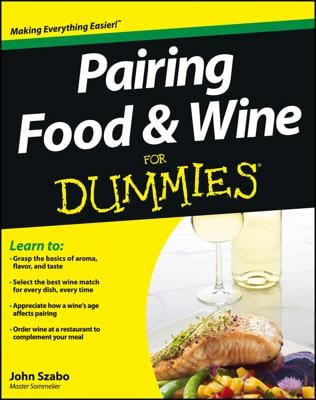Pairing food and wine 101
Although personal preference is an overriding factor when it comes to enjoying food and wine together, most people can agree on the outcome, positive or negative, of a few basic taste interactions. The following points lay out some of these basic ground rules for happy food and wine relations, which work toward highlighting the positive sides of either the food or wine, or both, and downplaying the negative aspects. Follow these suggestions and you’ll be a little closer to food and wine harmony.
-
Match weight with weight. Serve dry, light-bodied, low alcohol wines with light dishes (raw/fresh, crunchy, low fat, and high acid). Serve full-bodied, ripe, high alcohol, creamy-textured wines with heavy foods (including foods that contain a lot of dairy or animal fat, protein, rich sauces, and so on).
-
Serve high acid wines with high acid foods. For example, serve a dry Riesling, tart Sauvignon Blanc, or zesty Sangiovese with salads dressed with vinaigrette, goat’s cheese, tomato-based dishes, and such.
-
Avoid tannic wines with fatty/oily fish. For example, avoid a big, chewy Cabernet Sauvignon or Malbec with mackerel, black cod, salmon, or any other fish rich in Omega-3 fatty acids.
-
Soften tannic wines with salty, fatty, protein-rich foods. Tannic wines are astringent and mouth-puckering, so a protein-rich food, such as well marbled beef properly seasoned with salt softens the astringency sensation.
-
Serve salty foods with high acid wines. For example, serve Gamay (such as Beaujolais) or Barbera from Northern Italy with cured meats, or Italian Pinot Grigio with anything containing soy sauce.
-
Serve off-dry or sweet wines with slightly sweet or sweet foods. Remember: The wine should always be as sweet or sweeter than what’s on the plate.
Considering versatile white wines and bubbly
Serve any of these crisp, dry whites with just about any food, and you can avoid natural taste disasters. These versatile white wines (and Champagne) are also great when the meal includes multiple dishes on the table at the same time. Note that the regions or appellations and countries listed in brackets next to the grape are the archetypes, but not the only source of these versatile wines.
-
Unoaked Chardonnay (Chablis, France)
-
Sauvignon Blanc (Sancerre, France)
-
Muscadet (Loire Valley, France)
-
Pinot Gris (also known as Pinot Grigio) (Alsace, France and Northern Italy)
-
Grüner Veltliner (Austria)
-
Albariño (Rias Baixas, Spain, Vinho Verde, Portugal)
-
Riesling (Germany; international)
-
Chenin Blanc (Loire Valley, South Africa)
-
Semillon (Hunter Valley, Australia)
-
Champagne (France; as well as most sparkling wine)
Pairing food with versatile red and pink wines
When you’re not sure what wine to serve, look to one of these zesty, not too oaky, low tannin (not overly mouth-puckering) reds or anything similar in style. Remember that the more expensive the wine, the more distinctive it will be (or should be), but also the less food-versatile it will be. Inexpensive reds are generally more easy-going. The countries, regions, or appellations shown are where to find the original archetypes of the style, but not the only source.
-
Pinot Noir (basic Bourgogne Rouge, France)
-
Gamay (Beaujolais, France)
-
Barbera (Barbera d’Asti, Italy)
-
Sangiovese (basic Chianti, Italy)
-
Valpolicella (blend; Italy)
-
Grenache (Côtes du Rhône, France)
-
Cabernet Franc (Chinon or Bourgeuil, France)
-
Merlot (soft and fruity, new world–style, such as Central Valley, Chile)
-
Tempranillo (Ribera del Duero or Rioja, Spain)
-
Dry Rosé (blend; Côtes de Provence, France)
Dealing with spice when you pair wine and food
Really spicy foods can ruin the enjoyment of wine (or anything else you drink alongside), but mildly spicy foods can be paired effectively. When your dishes include a lot of spice, follow these tips to ensure you find a pairing that works:
-
Choose low-moderate alcohol, off-dry or sweet wines. These wines lessen the burn.
-
Serve wines (even red wines) chilled. Cool liquids provide some temporary temperature relief.
-
Select ripe, fruity, higher alcohol wines that have the body and implicitly sweet fruit flavor to handle spice. Because capsaicin, the compound responsible for the burn in chiles, is soluble in alcohol, choose wines up to 14 percent alcohol. Wines with alcohol higher than 14 percent increase the burn, however.
-
Avoid really oaky, tannic wines. Spice exaggerates oaky flavors, and tannins become more astringent and mouth-drying, neither of which are positive changes.
Serving wine and cheese: What works well
Far from foolproof, cheese can be tough on wine. And contrary to popular belief, whites often fair better than reds. For your next wine and cheese party, try serving the following combinations for a tasty evening:
-
Goat’s cheese with light, crisp, dry whites such as Sauvignon Blanc
-
Bloomy rind cheese with soft, wood-aged whites, such as barrel-fermented Chardonnay
-
Washed rind cheeses with full-bodied, aromatic, fruity (spicy), round whites, such as Gewürztraminer
-
Hard cheeses with full-bodied, robust reds, such as Amarone della Valpolicella
-
Blue-veined cheeses with sweet, late harvest or fortified wines, such as Icewine or Port

